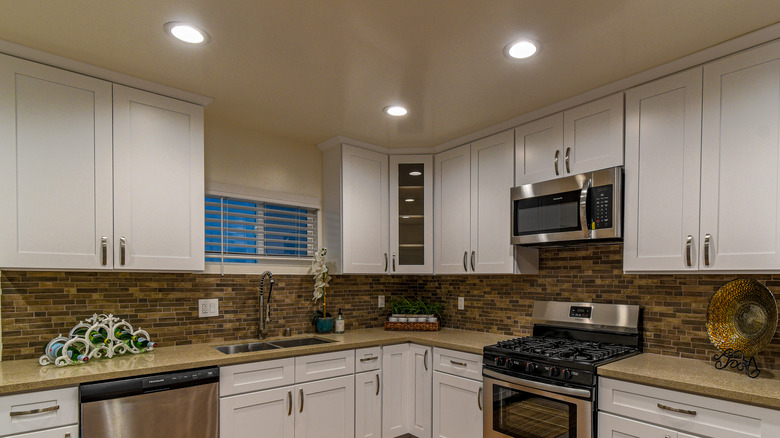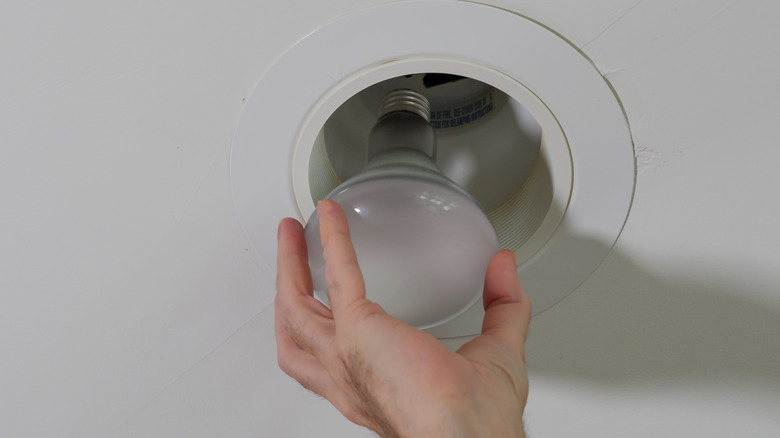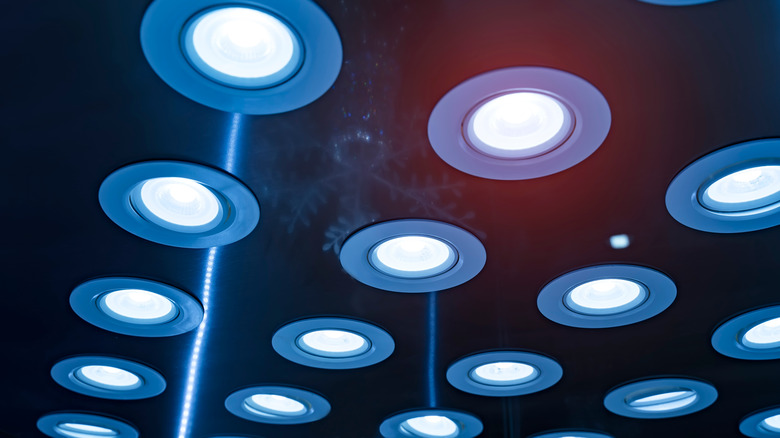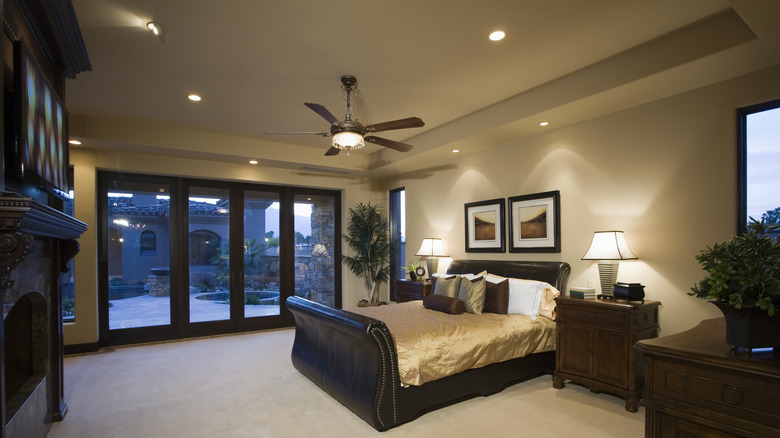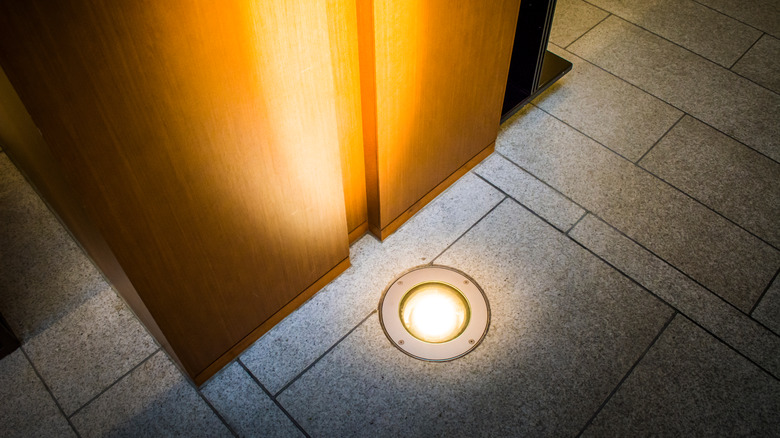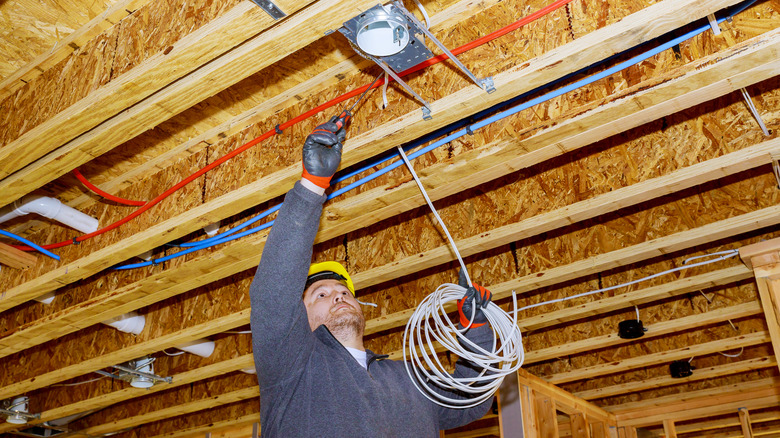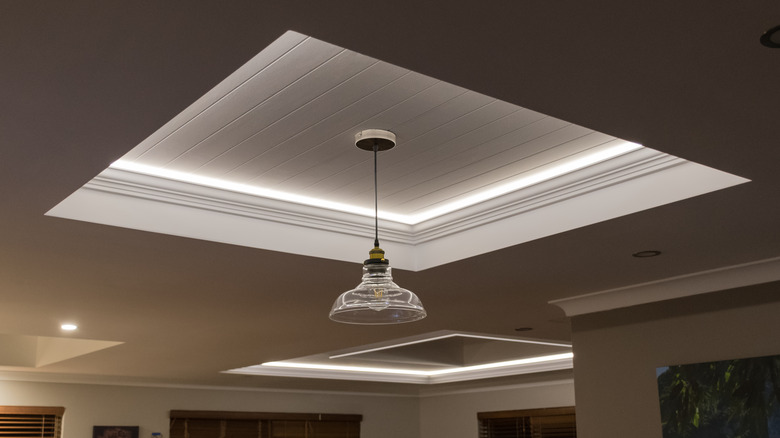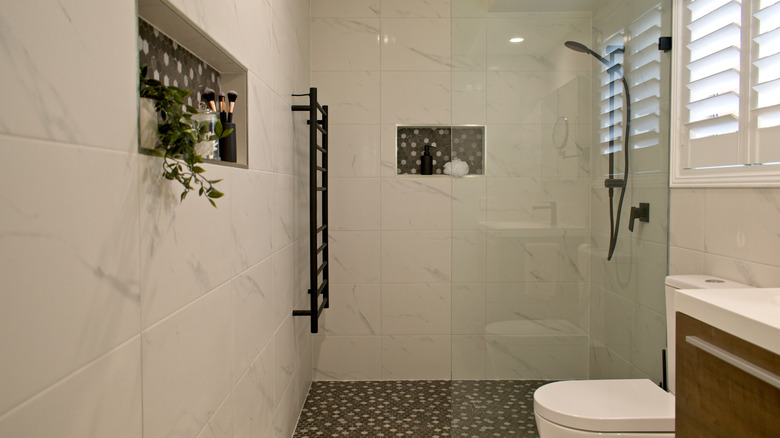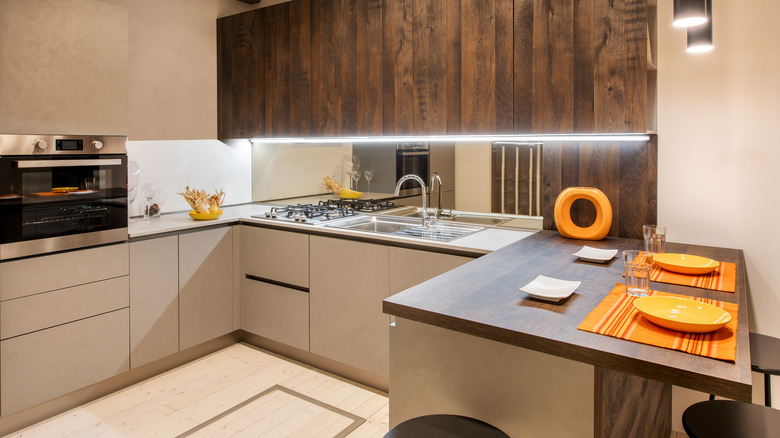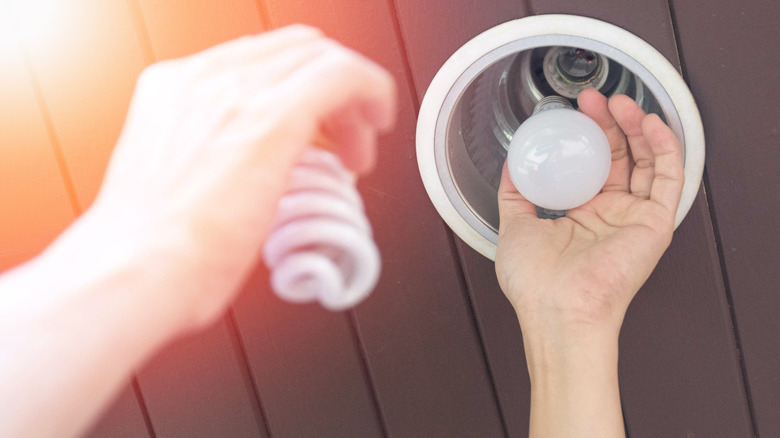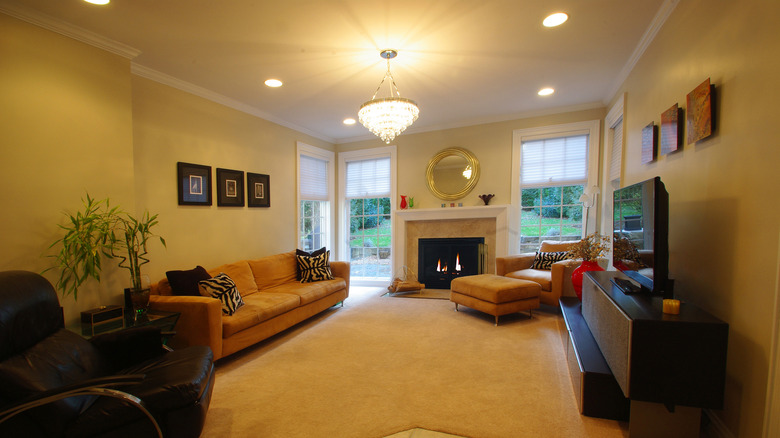Recessed Lights: What To Know Before You Buy
We may receive a commission on purchases made from links.
Recessed lighting is a popular form of lighting that negates the need to purchase flashy, expensive fixtures. According to Destination Lighting, recessed lights are placed in the ceiling or walls of a room and use large bulbs to provide plenty of light throughout the entire space. If you're researching recessed lights, you likely have several questions about the best way to illuminate your home while considering costs, installation headaches, and a number of other factors. The good news is that they are versatile and can accommodate a wide range of budgets and styles.
Before purchasing recessed lights, you'll need to ask yourself which sizes and types work best for the space you're looking to light, as well as the tone of light that will match the mood you want to create (i.e., white, warm, etc.) You can also use recessed lights in areas other than the ceiling, such as around the base of a kitchen island or underneath cabinetry to light up countertops. There are a lot of possibilities to consider, and each one comes with its own unique price tag. Rest assured, however, that no matter your taste, there is a lighting option for you. Check out the following guide for everything you need to know before buying recessed lights.
1. What are the parts of recessed lights?
According to Lightology, recessed lighting components are straightforward and consist of two main parts: the trim and the housing. The main portion of the recessed light is the housing, which gets installed in the ceiling or wall. The housing is not visible from the outside and contains the electrical wiring and bulb socket where the light bulb is screwed into. It comes in various shapes and sizes based on the style of light chosen for a given space. It may look different depending on whether it is installed on a sloped or flat ceiling, and may also include a separate flat piece to conceal the light bulb once installed. Specifically, there are two different housing types for recessed lighting: "remodel housing" and "new construction housing." The components and structure of the parts differ on whether the lights are being installed in a brand-new space or one that is being remodeled.
The second component of recessed lighting is the trim, which outlines the fixture's exterior and presses flat against the wall or ceiling. The trim comes in multiple colors, shapes, and finishes, allowing users to customize their lighting and get creative when decorating their home.
2. Types of recessed lighting trims
When we think about different types of recessed lights, we think first and foremost of the trim. This is the component that will be most visible, aside from the bulb itself. There are various types of trims you can choose from to make your space uniquely yours. According to Destination Lighting, a lensed trim has a waterproof covering that is often opaque in color. A lensed trim allows you to use recessed lights in places prone to getting wet, such as the outdoors or in bathrooms. Another type of trim is a reflector, designed to enhance the amount of light being emitted and focus it towards one direction in particular. For example, a reflector may be placed over your kitchen island to better spotlight your workstation and meal prep area.
You may also have heard of baffle trims, which minimize the amount of light emanating from the light fixture. This is a great option to consider in a bedroom, where you typically want softer light as you're winding down for bed. Lastly, there is the eyeball trim, which allows you to shift the direction of the light by offering a shade on one side of the bulb.
3. Types of recessed lighting bulbs
In addition to choosing the ideal recessed light trim for your space, you'll also need to consider the type of bulb you'll use, which is sometimes sold separately from the recessed lighting fixture itself. According to Upgraded Home, many recessed lights integrate LED lights, making purchasing a separate bulb unnecessary. However, if this isn't the case, you can buy a separate LED light bulb, which you will screw into the housing component. These bulbs are hailed as the most energy-efficient, giving you more light for your buck. Another option is the traditional incandescent light bulb, consisting of tungsten filaments that light up when energy passes through them. While not as energy-efficient, they are a wallet-friendly choice.
You will likely come across the CFL light bulb during your search for recessed lighting, which lets off fluorescent light and boasts a lengthy lifespan. If you're looking to use your recessed lighting to provide focused light in one specific direction, then R-type light bulbs are your best option. These bulbs feature a frosted face and are prevalent in outdoor spaces and for accent lighting. Lastly, if you prefer bright, white light, look no further than the halogen bulb, which is known for letting off lots of light while utilizing less energy.
4. What size of recessed lighting is right for me?
The size of your recessed lights will likely depend on various factors. For example, smaller, 4-inch lights are typically regarded as more stylish, minimalist, and less in-your-face than their 6-inch counterparts, according to The Recessed Lighting Company. Ultimately, the size will depend on the size of the space you want to light. In larger rooms, such as living rooms and master bedrooms, the 6-inch recessed light may make more sense as it will offer a wider cone of light. In smaller spaces or spaces in which you've chosen to incorporate multiple types of lighting fixtures, the 4-inch recessed light will provide enough light without washing out the room.
When it comes to specialized recessed lights, such as accent lights or small lights installed in cabinetry, the size will depend on how much light you need for that specific space. The great news is that you can find recessed lights in various sizes and shapes, allowing you to maximize the amount of light an area needs without sacrificing style. The best rule of thumb for figuring out which size to go with is to decide whether you will use the light for general lighting, accent lighting, or task lighting.
5. How long do recessed lights last?
The length of time that recessed lights last depend on the light bulbs used. The House Shop points out that LED recessed lights have the longest lifespans, offering around 25,000 hours of light, or 3 to 6 years of use, before needing replacement. If you've decided to go with the incandescent bulb, you can expect a much shorter lifespan. They typically last around 1,000 to 2,000 hours, or just a few months. The CFL light bulb is a happy medium between the two, offering light that lasts anywhere from 6,000 to 15,000 hours, or a couple of years. As for the halogen bulb, you can expect anywhere from 2,000 to 4,000 hours of use, which places it a notch above the incandescent bulb, according to Bulbs.com.
Most people would be tempted to go for the most energy-efficient option so they wouldn't have to change bulbs frequently. However, LED lights aren't for everyone, and you must choose the type of light bulb that works best for your needs and space. In addition to the bulb, you may need to replace the trim if it gets damaged, and you might eventually have to replace the housing component if any of the electrical parts go haywire. However, these replacements should be rare, if ever.
6. Why you may need recessed lights
There are many benefits to installing recessed lights in your home. For starters, recessed lights tend to visually enlarge a room, which can be a huge plus if you live in a smaller apartment or house, per Root Electric. The reason behind this is simple: Recessed lights do not include a bulky fixture that must be hung, placed, or stood up in a room. These fixtures take up visual space and add weight, making some rooms feel cramped or overwhelmed.
Another benefit to installing recessed lights is their convenience. If you don't like to do a lot of house maintenance, they're a great pick for you. Recessed lights are compatible with LED bulbs, which maximize the amount of light you can use without requiring frequent replacements and high energy bills.
Recessed lighting is also necessary for anyone going for a more modern and nondescript look in their home. The lights can easily be hidden and customized, allowing you to create a minimalist aesthetic that feels airy rather than cramped. Lastly, certain spaces will require you to use recessed lights over other options, taking the choice from your hands. Such areas include showers, outdoor decks, and home movie theaters.
7. Why you may not need recessed lights
You may not need recessed lighting in your home if you have large rooms. According to Hunker, since recessed lights direct their light downward or just in one direction, they lose the ability to illuminate large amounts of space. If your room has a lot of square footage, you will be required to buy and install a large number of recessed lights, which wouldn't be efficient or budget-friendly.
Recessed lights also wouldn't fit people's aesthetic who like to decorate boldly or make a statement with their fixtures. Recessed lights are nondescript and are more suited for minimalist or quietly modern spaces. They are also unsuited for rooms that require a lot of bright light. Recessed lights tend to create shadows due to the downward focus of their light. This spotlight feature can be frustrating if the light isn't installed in the right place, throwing shadows where you need light. You may also find yourself bothered by the uncovered surface of the bulb, which can be jarring to look at if you don't have the right tone of light. While some of these problems can be fixed with the right type of light bulb and/or a dimmer function, you may be better off investing in lighting fixtures instead.
8. Where to install recessed lights?
While you can install recessed lights in any room of your choosing, there are certain spaces in which they work best. According to Southern Electrical Services Company, a kitchen is popular for recessed lights. You can place them underneath cabinetry and along a kitchen island or bar to provide focused light for specific tasks. Lights placed in the kitchen ceiling can also create a wall-washing effect, bringing attention to the cabinets and appliances.
Another great location for recessed lighting is in the living room, especially if you install a dimmer. The light provides a nice overhead beam without shining directly on anything in particular, such as the television. You can also strategically place recessed lights in the living room to highlight artwork and other focal points. The bathroom is another great choice for recessed lights as they provide a waterproof option.
When installing recessed lights, the placement of the lights is also important. You'll want to provide enough space between the lights without lining them up in a row, which feels dated. It is also recommended to hire a professional to install the lights to ensure they are not placed too close to the insulation in your walls and ceiling, and that the wiring is up to code.
9. Average cost of recessed lights
Like anything else, recessed lighting comes in a wide range of prices to meet any budget. Home Advisor estimates that you will spend anywhere between $100 to $480 per recessed light, depending on several factors, including style, size, material, and installation costs. The actual installation costs can range from $200 to $250, with each light requiring around 2 hours to install. If you need the lights wired into the ceiling, expect to add $70 to $140 to the total project cost. Keep in mind that if your electrician encounters any structural issues while installing the lights, such as needing to reposition heat ducts or joists, this will only compound the amount of money you invest.
Home Advisor also points out that installation costs can vary depending on whether your home is newly constructed or renovated. You'll likely shell out $200 to $300 per light for installations in already-existing ceilings, while new construction will require a more significant investment of $800 to $2,880 per fixture. The cost of the lights themselves will vary based on whether they are LED-based ($20 to $30 per light) and the type of housing required ($9 to $160 per fixture). Depending on the type you choose, you'll also pay an additional $15 to $60 for the trim. Finally, you should also account for another $8 for the wires associated with each light.
10. Potential cost savings of recessed lighting
While the cost of recessed lighting fixtures and their respective installation might be high, you will save money down the road depending on the type of light bulb you choose. The U.S. Department of Energy reports that lighting accounts for 15% of a home's energy bill. The key to reducing the amount of money you spend on electricity is using LED bulbs in your recessed lighting fixtures. Not only do they boast a longer lifespan than their counterparts, but they also use around 90% less energy. The great part about using LED bulbs is that they come in various types and colors, making them easy to adapt to the specific recessed light fixture you choose. You can also take advantage of dimmer and motion sensor functions to increase your return on investment.
Another way to make sure you are saving money in the long run when purchasing recessed lighting is to invest in airtight models. According to Lighting Tutor, if the housing component of your fixture has holes in it, then heat will escape from your room and into the floor or attic above. As a result, you will rack up your electricity bill. You should also make sure to properly insulate your recessed lights to avoid further energy loss.
11. Top brands of recessed lighting
Researching recessed lighting will bring up dozens of brands and models that can be hard to choose from. Fortunately, there is a smaller amount of highly-rated options that you can choose from for your home. For example, Bob Vila ranked the Amico 6 Pack Ultra-Thin LED Recessed Ceiling Light the best overall recessed light on the market due to its minimal design and option to change the light's color. They're also easy to install and provide an abundance of light with a low energy cost. The Lumary WiFi Smart LED Ceiling Light also ranked high on the website's top recessed lighting fixture list for its ability to sync with a user's smartphone and respond to verbal commands. It also provides a wide range of colors to create the mood you want any time of the day.
Electronics Hub recommends the 6-inch Ensenior LED Recessed Ceiling Light for a high-quality fixture that maximizes your energy savings. For those looking for non-LED recessed lights, Halo is another popular brand that manufactures a 6-inch Aluminum Recessed Lighting Housing for New Construction Ceiling, which pairs with a number of trims and bulb types. Alternatively, Halo also makes the modern and stylish 4-inch White Integrated Ceiling Light.
